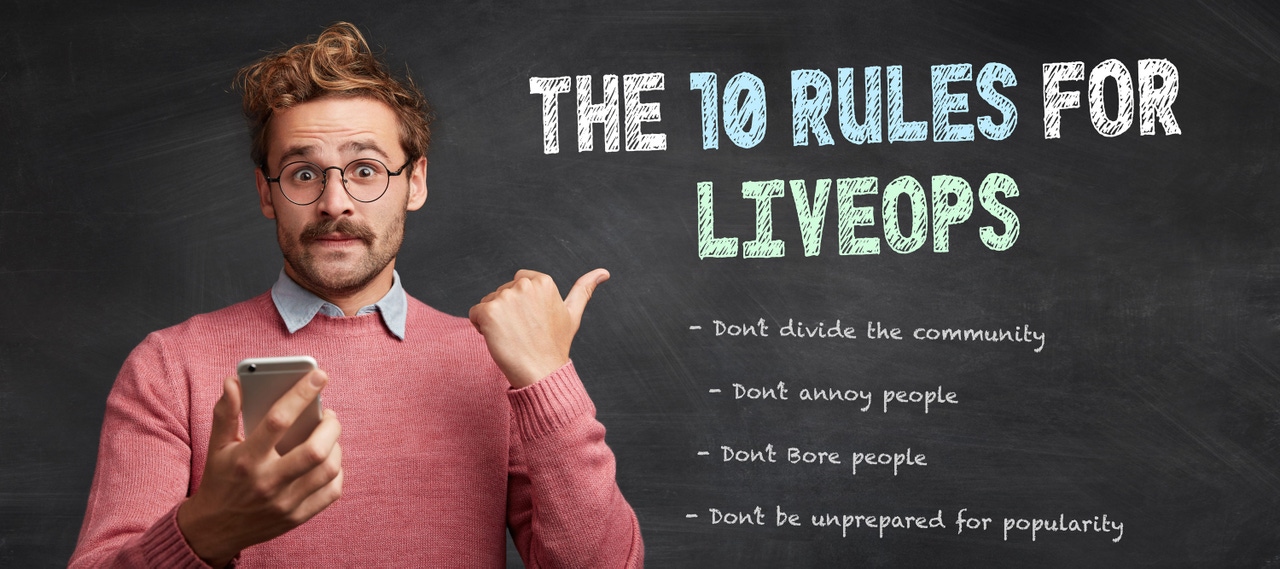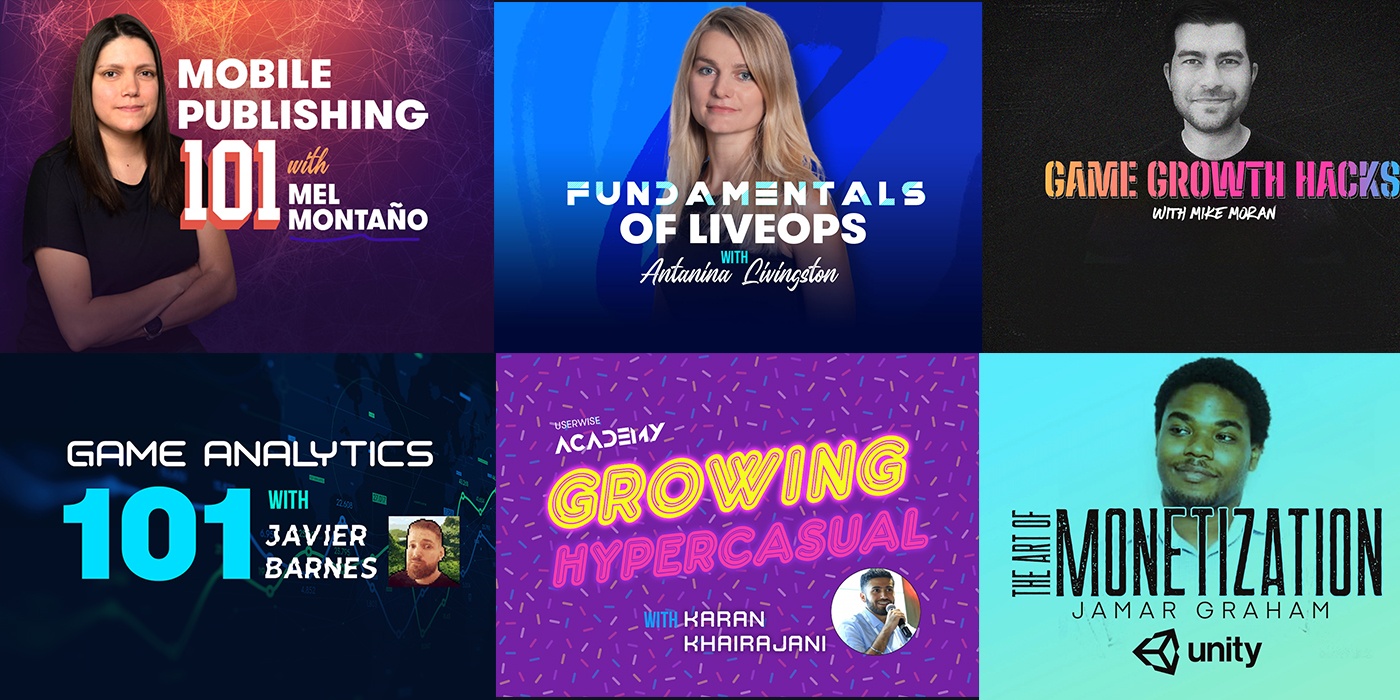Trending
Opinion: How will Project 2025 impact game developers?
The Heritage Foundation's manifesto for the possible next administration could do great harm to many, including large portions of the game development community.

Featured Blog | This community-written post highlights the best of what the game industry has to offer. Read more like it on the Game Developer Blogs or learn how to Submit Your Own Blog Post
In this article, we'll get into the pitfalls that catch innocent mobile game liveops professionals like you by surprise over and over again.

In this article, we'll get into the pitfalls that catch innocent game professionals like you by surprise over and over again. I get into the hidden dangers and the little-known traps, and I get into the assumptions that could lead to the destruction of everything you’ve worked hard to build.
Ready? Let’s get into it.

You’ve heard me talk about the merits of audience segmentation a thousand times, so maybe this feels a little off-brand. But bear with me. While it’s one thing to divide your playerbase into smaller groups to better understand behaviors, needs, and wants, it’s a totally different thing to divide them and make them aware of the division.
Nobody wants to feel like they’re getting the short end of the stick. It’s your job, as a game producer, to be observant without being opinionated. Although you may know which group of players spends the most money, don't forget about the others.
They deserve your time as well.
Like a parent with two kids, don't show preference or give one of your kids the better present this Christmas.
Whether they’re paying or not, whether they’re regulars or not, every player’s experience should be a priority. And that means every player should come into your game knowing they’re just as valued as everyone else.
It’s a pretty simple concept, and I have every faith you understand what I’m saying -- and dare I say, already agree with it. Which is great. But around here, we do more than just throw around theory. So let’s take a look at what it means for your practice.
Avoid Pay-to-Win: If you’re literally handing the players who pony up and spend the key to the game, you’re not just turning off the masses -- you’re also collapsing the point of playing the game. If you remove the need for strategy, skill, and experience, you remove the need for consistent gameplay. And the desire to play at all.
In Western markets, the consensus of players is to rebel against games that are wholly play-to-win because they blatantly prioritize the transaction ahead of the spirit of gaming. When the people who design the game are making it clear that only the players who dig deep into their wallets will have the wherewithal necessary to win, the sense of excitement -- and commitment to putting in effort -- is depleted.
Prowess no longer matters. And that kills games faster than any monetization drought you’re going through.
Be Specific with Content: Following the avoiding play-to-win at all costs notion, you need to be hyper-specific with your content delivery. While offering early access to exciting content releases -- for a price -- is fine, selling things like premium map DLC’s is not. You should never be giving away important milestones, required-to-win tools, or level-passing intel via your game store.
The point is to have an equal playing field, where all players -- regardless of spending history or potential -- have the same possibility of progressing. So use content to your advantage when it comes to exciting your audience and providing offers they want to spend on, but don’t use it to decide who wins and who loses. Keep the spirit of a meritocratic competition alive and your game will reward you. With its staying power.
Enforce Camaraderie: Every game needs competition, but the truly remarkable games go beyond investing in the competitive spirit. They invest in the community spirit. Because they know that their players -- like all humans out there -- are attracted to community. They’re compelled to come back to the places they feel welcome. And guess what? With some strategy, you can get that community spirit going strong.
Rather than pitting your players against each other at every turn, give them opportunities to share. To rely on each other for success and fun. Some examples? When a player spends on a 100% XP boost extender, automatically send a 10% mini bonus to their teammates. If an area of the game is locked behind paid access, give players the chance to spend for their own entry -- or to sponsor a friend.
Players that buy larger offer bundles might earn free gifts to distribute as they please; when their peers receive those gifts without having to spend money of their own, they don’t just feel included. They feel compelled to follow suit: to spend their own money and gift the people around them with perks of their own.
Proof that this works? In Team Fortress 2, one of the most popular for-sale items was a gift box that sent a reward to a random person on the server -- without any possibility of it going back to the buyer. People love to give. And when they get, they’re reinvigorated to give even more.
The moral of the story is, you have the power to create the type of world players will love. So will you create one that’s fueled by competition, money, and greed? Or will you create one that champions an even playing field -- where players are encouraged to share camaraderie alongside their genuine love of the game?
Corny as it may be, the difference is stark. And it’s entirely up to you. (And your LiveOps.)

You might think this tip is common sense, but you’d be surprised at how many games lose steam -- and their hard-won real estate -- because they don’t make it a priority. From an outsider’s perspective, it’s a big duh that under-promising and over-delivering is the way to go.
But from the inside of a game? From the LiveOps control room, the marketing room, and the investors’ room? Not getting caught up in the grandeur of enticing players with awesome claims is far trickier.
I’m not saying that you can’t wow the socks off of your audience in your marketing campaigns, and I’m not saying that you can’t sing the praises of your newest content release loudly. All I’m saying is that, when you do those things, it better be true.
It better have the substance it needs to back it up. To get your players saying, you know what? That was worth it. I’m glad I bit and downloaded the game; I’m glad I bit and spent $15 on the boost bundle.
That’s the goal. That’s what you’re aiming for. And that’s the trickiest target to meet. Because in today’s day and age, your audience isn’t exactly wowed easily. They have thousands of games all around them, making big promises and showing big displays of grandeur. They’re smart. They’re desensitized.
They know what real substance looks like, and they won’t settle for anything else.
You might think I’m exaggerating the importance of this tip here, but let me assure you: I’m not. Because should your claims not align with your offerings, and should your promises not align with what you’re putting on the table, your audience will react like this:
They Will Leave: As in, they’ll exit the game -- and not return. If you’re not meeting the description you’ve advertised, you’ve lost their attention. And it’s incredibly hard to get it back.
They Will Tell: As in, they’ll tell their network that they were disappointed. Friends, family, social media followers -- they have no reason to hide their displeasure, and they’ll want to help the people they like avoid the same disappointment.
They Will Resent: If you’re doing more than just not providing a fun game experience, like making false advertisements about offers or outright lying about aspects of gameplay, then you’re moving into dangerous territory -- and your players will respond in kind. They’ll feel betrayed, slighted, and they’ll want to give you a taste of your own medicine. Maybe that’s publicly describing the betrayal, maybe it’s writing a game review or Tweeting at members of your team. Whatever it is, it can get ugly -- especially when there’s real resentment present.
They Will Refute: And on the monetization side of things, their distrust, annoyance, and even anger will cause them to demand a refund on their purchase. Maybe the bundle didn’t affect their gameplay the way the offer promised it would, or maybe the expensive boost didn’t improve their standing the way they expected. Marketing offers is important, but false advertising is dangerous -- and won’t just lose you monetization traction in the short-term, but will also lose you players in the long-term.
So there you have it: the exact reason behind why audience disappointment and regret cost you. It’s about making sure your marketing stays grounded (despite your instinct to talk up the fruits of your labor -- which you should, but carefully), and it’s about ensuring your substance is up to par.
Do that, and you won’t need to worry about any of those actions. You’ll be sitting pretty with an excited audience that can’t wait to spend some more.

Going into your liveops, your main concerns are probably 1) releasing cool enough content, and 2) getting enough players into the game to see it. I get it: those are the biggest, fastest-moving parts, and they have the shiniest sense of appeal.
But I’m here to tell you that the success of both of those factors relies on a sound foundation. A sound technical foundation. And if you overlook the significance of having your technical base squared away, you’re leaving yourself vulnerable. (To cracks, crashes, and worse: total audience disappointment.)
So how do you get proactive to make sure that doesn’t happen? You craft a list of questions -- and make sure the answers, at every point of new release, are the answers you want to be seeing. Here’s a sample list to get your mind moving:
How long is the user spending on the initial loading screen?
Does the game download only what it needs and when it needs it, or are your players getting charged intensely for their bandwidth?
Is the game’s performance consistently smooth throughout play sessions, or does it falter at the most intense, climactic junctures?
You might think that tiny technical hiccups or three second-long delays aren’t all that detrimental to the overall value of your game, but you’d be wrong. Because it’s not just about those lost three seconds. It’s about what they represent.
If you’re hitting users with tedious wait times on the loading screen, you’re telling them that their time doesn’t matter to you. If your excessive downloads eat up their precious storage space, you’re telling them that you haven’t given thought to their whole experience. If things get spotty (with crashes or jitters) right when their play session is getting good, you’re giving them no reason to trust that your game is the real deal.
Your players are your customers. They’re the difference between your game sticking around for years to come and falling off the map tomorrow. Tiny hiccups to you might be the push they need to get out now, wiping any trace of the game from their phone without further thought.
Don’t overlook the technical. Because with LiveOps, every second matters.

A game might be revolutionary when it first hits the market. But if it keeps its story the same, if it fails to incite new challenges and if it fails to offer new prizes, then it won’t have any chance at keeping its audience’s attention. Their excitement will wane, and wane, and wane. Until it’s gone.
Now, that might seem dramatic to you, but this tip is all about keeping audience engagement, excitement, and joy for the game growing -- rather than shrinking. Rather than waning away.
What sort of practical techniques do I have for you to make sure you’re building interest instead of depleting it? The truth is, to get the sustained engagement you’re looking to see, you don’t need to overhaul your game or revolutionize the player experience on a frequent basis. Or even at all.
What you do need to do is get strategic. As a human, what do we know that people everywhere love? Things that are luxurious, things that are new, and things that are exclusive. In other words: people love the rare. They love what other people can’t get their hands on.
Use that simple, baseline psychology to your advantage. And it doesn’t need to come through via a grand offering or a reimagined play session; it can be as easy as turning a mundane reward into something scarce.
Ah, yes. The ‘s’ word. Scarcity is the concept that can take your rewards, your competition, and your game to the next level. A plain old icon or run-of-the-mill badge might start off as boring -- an aesthetic reward and nothing else. But if you reduce their availability, if you remove 95% of them from the world of the game, then you’re making them valuable.
You’re transforming them into powerful markers of tenure. Where only the players who’ve been with you since the beginning get to have them.
This will keep those old players excited and coming back because they feel valued, but it’ll also keep the newer players interested -- because they have something clear-cut to work towards. (Maybe if they stick around for long enough, they’ll get a token to call their own too.) Scarcity inspires motivation from all of us, so lean on it. But once it starts to work, don’t get tempted by the easy cop-out.
You know what I’m referring to: the moment where you realize your scarcity method has paid off and there are thousands of players searching for those few-and-far-between rewards. You could enact an accessible avenue for acquiring them, earning yourself a clear revenue spike. Or you could take the high road.
I’ll tell you why I’m a proponent of the high road -- the road where, instead of reeling in a short burst of revenue, you keep your eyes peeled on the future. You invest in the engagement that’s accumulating because you’re keeping scarcity at the driver’s seat, and you find creative ways to keep that spark of possibility for your audience alive.
Maybe that means a challenge that sends one of those tokens to the winner -- so the token starts to symbolize talent alongside tenure. Or maybe it means giving out daily rewards to encourage consistent gameplay, where 100 daily tokens can be exchanged for one of those rare tokens -- so it starts symbolizing persistence alongside tenure.
That last example was nearly a tip in itself, hitting two birds with one stone by maintaining the allure of scarcity while inspiring daily retention to take off. I’ll note here, in case you want to take the idea and run with it, that you should focus on rewarding gameplay rather than attendance. (They get tokens for accomplishing tasks, not for merely logging in.)
For a swift recap: avoid boring your audience and depleting their once-enthusiastic excitement by turning ordinary rewards, badges, or abilities scarce. One method of doing that is through the positive reinforcement of daily play -- allowing you to check off two behavioral boxes at once.
Hopefully this tip encourages you to keep thinking creatively -- because with LiveOps and with games, big-picture, innovative thinking is the only thing that earns you staying power.

Just as important as not boring your audience is not annoying your audience. Stick with me. In today’s day and age, your players are no stranger to digital marketing tactics; in fact, they’re assaulted by a near-constant barrage of them throughout the day.
From the moment they first check their inbox in the morning to the targeted ads they see while scrolling their social media feeds at night, they’re accustomed to brands they’ve interacted with -- and brands they haven’t -- talking at them. They’re accustomed to the sales verbiage and the exclamatory subject lines, and they’re accustomed to the carefully compiled and curated digital posts.
I’m not saying don’t leverage the power of digital marketing and notifications. For your LiveOps strategy to pay off as much as it possibly can, you need those tactics in your corner. What I am saying, however, is that you need to be deploying them intelligently.
Because the point is to inform your audience. To catch their attention and to drive them to get back to the game. Annoying them, overwhelming them, enraging them? None of that will earn you the results you’re shooting for.
Here’s how you achieve the pros of digital marketing tactics -- without any of the cons:
Be Allergic to Spam: When it comes to your newsletters, social posts, and notifications, you need to be vigilant. The line between effective deployment and counterproductive effort is thin -- if you overdo your emails and posts and send notifications without restraint, you’re giving your audience reason to want to ignore you. So it’s your job to be mindful. The golden rule? Quality over quantity.
Your CCS, social, and marketing staff should be working -- under your guidance -- to give players bite-sized pieces of value in a controlled way. Whether that’s releasing sneak peeks of new features and events, community highlights, Q&A’s, or bonus videos and surveys, the through-line should be utility. If your efforts are focused around adding something to your audience’s lives, then the quality is there.
Lean Into Localizing: We’ve spent a good deal of time covering the basics of localization in previous articles, and while the strategy’s integral to successful LiveOps -- it’s also crucial to effective marketing tactics. Here’s how to utilize it: once your team establishes a plan for newsletter, post, and notification releases, it’s your job to make sure that plan is tweaked for each local region.
Take your audience’s time zones into account as you cue up your releases, and ensure that the same schedule is applied to every regional player segment. When you do that, you confirm that your players won’t be woken up by a 2am notification -- but you also guarantee that the tactics will hit them at a time when they’re ready to visit the game. (Because an email that’s been sitting in their inbox all through the night will likely be trashed before it can even be opened.)
Localizing your tactics helps you meet your goals. In digital marketing, notifications, and LiveOps -- and beyond.
Notify With Care: When it comes to your notifications -- both push (sent by the server) and local (sent from within the app) -- you have to be aware of more than just the frequency. You have to be aware of the content. Typically, the game designer is in charge of both factors, which means you should be weighing each equally.
Just like with LiveOps as a whole, nailing the release frequency is crucial to making sure players are getting what they want when they want it -- and aren’t getting hit with 5 notifications within half an hour of leaving the app. But when it comes to the notifications’ content, figuring out the right notes to hit is just as crucial.
The focus for content should be on contextually relevant doses of information or excitement. Did they leave the app after losing a challenge? Hit them with a notification that offers a reduced price for a new boost. Have they been stagnant for a while? Send them an invitation to an exclusive upcoming event. Get creative, get proactive, and get fruitful. But whatever you do, don’t get lazy.
While this tip is oriented around the don’t be annoying commandment, its techniques can really help you achieve much more than that. They’ll help you abstain from the obnoxious title, yes, but they’ll also help you prompt intrigue, excitement, and action. Because when you hit the right marks at the right times, beautiful things happen.

I’m going to let you in on a little secret: the thing you’re shooting for? It can kill you.
The rationale behind that sentiment stems from the network effect, which dictates that, when the value of a product or service increases, so too does the number of its users. In other words: it’s a positive feedback loop between perceived value and popularity. And while that’s the goal we’re aiming for, it’s also the result that can degrade our technological efficacy -- if we’re not prepared for it.
Let’s look at a hypothetical: in an MMO game (like Second Life, for instance), we have a player who spends a good chunk of time designing a new hat for their character. When the character dons the new hat for their next game session, they receive a good dose of attention from their peers -- inspiring them to spend more time, say, a couple of days, designing a whole new outfit.
When the new outfit’s ready to be shown off, where do you think the player goes? To the most populated places within the game, of course! They’re looking for optimal amounts of recognition, so that requires optimal amounts of eyes on them. And when they get what they’re looking for, the people giving it to them -- the other players -- realize that they too want to be the belle of the ball.
So they go design their own hats, and their own outfits. And they go to the most populous places in the game, seeking out hungry eyes. And just like that, your popular locations become even more popular -- every player wanting a piece of attention for themselves.
Now, in this hypothetical, there wasn’t sufficient planning in place to account for the change in the locations, map, and server’s popularity. The result? An unplayable game -- with frame rate issues, server failures, and swaths of disappointed (or worse) customers.
It’s an age-old story -- falling victim to your own success -- and I speak of it here to instill in you the urgent need for preparation. Don’t collapse under the weight of your own popularity, and don’t encourage players to play if you can’t guarantee they can do it safely. Always, always consider the risks of you hitting your goals -- and make sure you do everything you can to mitigate them ahead of time.

When we’re designing a game, as game professionals, our instinct is to think as game professionals. We’re up to date with what the latest games are doing, we’re well-versed in which elements are necessary to be technologically competitive, and we’ve done our research into the latest and greatest tools.
Check, check, and check.
From an objective expertise-driven standpoint, we’re killing it. But… we’re still missing something. We’re so busy doing things the standard way, the checking-off-boxes way, that we forget to take in a whole other viewpoint.
We forget to immerse ourselves in our playerbase. We forget to look at things through their eyes.
What do they want? What will they enjoy spending money on? What will surprise them in a high-value way, and what will enforce the sense of community we’re aiming to consistently evoke?
By doing a deep-dive into these questions (and whatever other questions you come up with), you’re not just empowering your game to meet nuanced needs and attract players more earnestly -- you’re actually setting yourself up to better understand the whole industry.
Think about it like this: you’ve spent the vast majority of your operational effort figuring out the product stuff -- how to make your game as flawless as possible, as innovative as possible, and as lucrative as possible. But you haven’t spent that same effort getting to know your customers. And without that insight, you’re basing your product off of the aims of other products.
You’re failing to leverage the power of audience intel for all it’s worth.
To avoid that pitfall, here’s what you do:
Embrace the wide range of player archetypes you know to exist -- don’t just focus on one, and don’t just focus on ‘audience’ as a whole.
List their motivations, desires, and grievances -- what’s stopping them from spending more, playing more, or entering the app at all?
Prove your own points by having your team get into the game themselves, playing (and spending!) ‘undercover’ alongside your audience -- by living the experience they’ve been brainstorming, they’ll have a better sense of the emotional ups and downs.
You’re molding a game that, first and foremost, speaks to its audience. To do that successfully, you need to know who you’re speaking to. And you need to apply that insight intentionally, so that whatever your game says actually resonates.

The power of rewards is immense; from our thorough study of liveops, you already know that to be the case. Wield them effectively and your players will dance, but wield them ineffectively? Fail to offer meaningful prizes or offer so many prizes that they lose their value? Your players won’t dance -- they’ll leave.
So, yes, rewards are the key to the whole thing. But what is the key to rewards?
Consistency. Con-sis-ten-cy. The thing is, rewards are your players’ shiny carrots, motivating them to play longer, harder, better. They’re conscious of the thing they’re working towards, and because of that, anything reward-related they will remember.
Did they win the bundle? Did they lose the challenge and have to watch as a peer was crowned with the cosmetic token? Whatever happened, it’s ingrained in their memory. And it’ll either motivate them or detract them from returning to the app.
So now imagine that a player who’s been playing towards a reward for weeks is privy to a random spark of reward generosity: they’re in a play session, and suddenly everyone playing receives a small reward. Confusing, but doesn’t wholly remove their interest in pursuing the larger reward. So the next day they’re back in the app -- and they see that the reward they’ve been striving for has been set as the prize for a challenge.
A relatively small challenge. A challenge that would take the rareness, the value, away from the reward.
You’d be frustrated, wouldn’t you? Turned off? Enraged?
Inconsistent reward policies, changing bundle and gacha offerings, and unstable customer support (via compensating or assuaging angry players) lead to disillusioned players. And worse. If they can’t depend on the expectations they had going into their gameplay, then why trust the game at all?
Why work hard to reach a reward only for it to be offered for half the effort to everyone?
Without consistency, your reward system -- and your overall game economy -- will struggle. It takes planning, it takes cooperation, and it takes diligence. But when you achieve it, you’ll achieve optimal allure. And sustain it.

For our ninth tip, we’re coming in short and sweet: you need rules in place to ensure your players can never stockpile their goods.
The context? To any resource-based economy, excessive hoarding of resources is a fundamental threat. Not only does it reduce the motivation of those with the resources to continue on playing, but it also reduces the motivation of those around them -- if they can never catch up to that level of wealth, what’s the point?
As a game designer, it’s your responsibility to ensure the playing field is as equitable as possible. That means there should be fail safes in place to limit the amount of resources and consumable items players can hold onto -- and not just in theory, but in practice.
It’s one thing to announce the rules; it’s quite another thing to enforce them. And you need to be prepared to do the enforcing. Give your team the why rationale and develop processes that either stop players from accumulating items beyond a certain threshold or alert your team when an ‘illegal’ stockpiling has occured, and then you’ll be equipped to tackle the problem head-on.
Remember: the more prepared you are, the less you’ll have to worry about in real-time. That’s the power of insight.

Let me repeat that. Don’t lose the battle because you were focused on the war.
Sound backwards? Hear me out: in Free-to-Play games, your audience has no investment in their decision to download the app. They have no pressing need to enjoy it, and they have no pressing need to stick around if it doesn’t immediately demand their attention. In other words -- they’re not losing anything by leaving.
They put no money down, so the exit door is wide open. And that means you have less than 15 minutes to hook them.
If you can’t wow them with a strong gameplay hook, an expertly defined long-term premise, and a real, verifiable reason to return, then they won’t. And that, my friends, is your battle: giving them exactly the right dose of excitement, of sustainable play potential, to make them want to stick around.
And that takes us to the war. The overarching game and all of its teeny-tiny component parts. Naming the player profile. Selecting the servers. Tweaking the difficulty settings. These details are important to you, there’s no doubt about that, but if you were to allocate the majority of your focus to them and forget about the battle -- the hook -- then you’d be losing before you even got started.
You have 15 minutes to blow the socks off of your players. Like the 60 second trailer for the newest action movie, if you don’t convey the excitement and the why should we care answer fast enough, that’s it. You’re toast. No-one’s venturing out to see the movie, and no-one’s heading back into the game.
The mundane bits and pieces can wait. I promise you. To get your audience interested in a long-term relationship with your game, here’s what you need to be doing as you prepare for the battle:
Establish the Right Premise: Whether it’s collecting all of the characters, solving the mystery, building a city, exploring uncharted lands, or winning the championship -- your players need something to work towards. And they need it defined clearly from the jump.
Reveal the Good Stuff: Give your players a taste of what’s waiting for them down the road way before they get there. How? Utilize onboarding segments or ‘teaser’ challenges to expose them to the best elements of your game -- if you’re a sports game with world-class athlete characters, have your players’ first match be with those stars on the court. Then, throw them into matches with no-names so they can work back to that value.
A small note about onboarding segments: don’t stress about new users’ initial experience until you’re already deeply into production. The best way for these segments to thrive is when the game mechanics are already established and there’s understanding and flow regarding game content, so get comfortable with the idea of iterations.
Preview Content Firsthand: In the same vein, oftentimes telling players about what’s waiting for them down the road isn’t enough -- whether it’s a new weapon, a new vehicle, or a new character. As cool as you think your graphic/text/video showcasing the new content is, it doesn’t come close to experiencing the real thing firsthand. So give your audience the chance to try it out for themselves: for a minute, for a mini-challenge, whatever you choose. It’ll serve you better, because they’ll be way more excited about it and want to put in the effort for it, and it’ll boost your users’ experience at the same time.
There’s no getting around that the whole war is important. You want every aspect of your game to be killing it, for every second it’s out there in the world.
But if you lose this first battle, that war becomes obsolete. It’s not that you’ve forfeited your right to fight it; it’s that it simply no longer exists at all.
Don’t bypass the battle for a war that might not come to be. Focus on your game’s hook -- on its premise, its excitement, and its sustainable allure. Because when you do that, your players will keep coming back. And the details of your war will be waiting.
The point of liveops is to create a sustainably relevant, exciting, and adored game. Having the right foundation and the right core strategy pieces is important, but being able to connect those tenets through esteemed tips & tricks is revolutionary.
It’ll give you the oomph you need to stand out in a crowded market. It’ll give you the confidence you need to make new moves and innovate in new ways. And it’ll give you the spark you need to create something un-ignorable… that actually lasts.
I hope you take the pointers in this article and run with them. I hope you keep them locked and loaded in your mind as you mold your game’s liveops tactics, and I hope you use them to avoid problems, pitfalls, and -- worst of all -- complacency.
Crafting a game, and crafting a game’s liveops, is a living, breathing undertaking. You need to be knowledgeable, you need to be astute, and you need to be unforgiving in your quest to grow. I’m certain that these tips & tricks will help you be all of those things.
And, if I did my job right, a whole lot more.
While that’s it for our LiveOps Essentials series, I want to emphasize that we’re not done here, you and me. Not even close. I have a new series coming to you -- this one focusing on the ins and outs of the sacred game economy -- and it’s sure to teach, expose, and inspire with as much gusto as this one.
Yeah, that is a promise. So buckle up and I’ll see you there.
Til’ next time.
-------
PS
We recently launched the UserWise Academy - a place for you to go and take free online courses taught by some of the brightest minds in mobile gaming.
The courses are 100% free and include:
Unlimited access to exclusive video tutorials presented by top gaming experts.
Tips and tricks from people who have “been there, done that.”
A community with people just like you who are excited to learn.
Click on the courses to start watching. Easy peasy.

Read more about:
Featured BlogsYou May Also Like